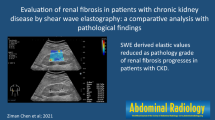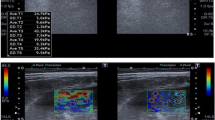Abstract
Purpose
Hepatocirrhotic nephropathy progresses rapidly and has a poor prognosis, and early detection of renal changes in patients with cirrhosis is particularly important for its prevention and treatment. The objective of this study was to evaluate the value of shear wave elastography (SWE) in the early diagnosis of hepatocirrhotic nephropathy.
Methods
206 hepatic cirrhosis patients with normal conventional renal function were enrolled and divided into Child–Pugh grade A (Group A), Child–Pugh grade B (Group B), and Child–Pugh grade C (Group C) according to the Child–Pugh grading method. Meanwhile, 60 healthy volunteers matched in age and sex were selected as the control group. The maximum Young’s modulus (Emax), average Young’s modulus (Emean), and minimum Young’s modulus (Emin) of the left renal parenchyma were measured by SWE in all subjects. The Emax, Emean, and Emin values of the left renal parenchyma were compared between the cirrhosis and control groups.
Results
The Emax, Emean, and Emin values of left renal parenchyma in cirrhosis group were higher than those in control group (p = 0.00, 0.00, 0.00). The Emax, Emean, and Emin values of left renal parenchyma in cirrhosis group B and group C were higher than those in control group (p = 0.00, 0.00, 0.00; p = 0.00, 0.00, 0.00), but these values in cirrhosis group A were not significantly different from control group(p = 0.48, 0.52, 0.92). Comparison of the Emax, Emean, and Emin values in left renal parenchyma of three cirrhosis groups, the values of Group B and Group C were higher than those of Group A (p = 0.00, 0.00, 0.00; p = 0.00, 0.00, 0.00), and there was no significant difference between Group B and Group C (p = 0.71, 0.18, 0.39).
Conclusion
SWE can detect renal tissue damage in patients with liver cirrhosis earlier than changes identified during routine laboratory examination by quantitatively measuring the elastic parameters of renal parenchyma and may become a new method for early diagnosis of hepatorenal syndrome.
Graphical Abstract


Similar content being viewed by others
Data availability
The datasets analyzed during the current study are available from the corresponding author on reasonable request.
Abbreviations
- BMI:
-
Body Mass Index
- Emax:
-
The maximum value of Young’s modulus
- Emin:
-
The minimum value of Young’s modulus
- Emean:
-
The mean value of Young’s modulus
- HRS:
-
Hepatorenal syndrome
- SWE:
-
Shear wave elastography
- US:
-
Ultrasonography
References
Ginès P, Solà E, Angeli P, et al. Hepatorenal syndrome. Nat Rev Dis Primers, 2018,4 (1):23. https://doi.org/10.1038/s41572-018-0022-7.
Alessandria C, Ozdogan O, Guevara M, et al. MELD score and clinical type predict prognosis in hepatorenal syndrome: relevance to liver transplantation.Hepatology,2005,41(6):1282–1289.https://doi.org/10.1002/hep.20687.
Wang L, Xia P, Lv K, et al. Assessment of renal tissue elasticity by acoustic radiation force impulse quantification with histopathological correlation: preliminary experience in chronic kidney disease[J]. Eur Radiol. 2014,24(7):1694-1699.DOI:https://doi.org/10.1007/s00330-014-3162-5.
Gennisson JL, Grenier N, Combe C, et al. Supersonic shear wave elastography of invivo pig kidney: influence of blood pressure, urinary pressure and tissue anisotropy[J]. Ultrasound Med Biol. 2012,38 (9) :1559 – 1567. DOI:10.1016/j. ultrasmedbio.2012.04.013
Piano S, Rosi S, Maresio G, et al. Evaluation of the Acute Kidney Injury Network criteria in hospitalized patients with cirrhosis and ascites[J].J Hepatol,2013,59(3):482–9.DOI:https://doi.org/10.1016/j.jhep. 2013.03.039.
Marta ML, GuevaraM, TorreA, et al. Prognostic importance of the cause of renal failure in patients with cirrhosis. [J].Gastroenterology,2011,140(2):488–496.e4. DOI:https://doi.org/10.1053/j.gastro.2010.07.043.
Fagundes C, Ginès P. Hepatorenal syndrome: a severe, but treatable, cause of kidney failure in cirrhosis. [J].Am J Kidney Dis,2012,59(6):874–85. https://doi.org/10.1053/j.ajkd.2011.12.032.
Warner L, Yin M, Glaser KJ et al. (2011) Noninvasive in vivo assessment of renal tissue elasticity during graded renal ischemia using MR elastography[J]. Investig Radiol 46:509–514. DOI:10.1097/ RLI.0b013e3182183a95.
Lukenda V, Mikolasevic I, Racki S, et al. Transient elastography: a new noninvasive diagnostic tool for assessment of chronic allograft nephropathy[J]. Int Urol Nephrol,2014,46(7):1435-1440.https://doi.org/10.1007/s11255-014-0697-y.
European Association for the Study of the Liver. EASL Clinical Practice Guidelines for the management of patients with decompensated cirrhosis[J].JHepatol,2018,69(2):406–460.DOI:10. 1016/j.jhep.2018.03.024.
Hassan K, Loberant N, Abbase N, et al. Shear wave elastography imaging for assessing the chronic pathologic changes in advanced diabetic kidney disease [J]. Ther Clin Risk Manag 2016,12 1615–1622.https://doi.org/10.2147/TCRM.S118465
Early H, Aguilera J, Cheang E, et al. Challenges and Considerations When Using Shear Wave Elastography to Evaluate the Transplanted Kidney, With Pictorial Review[J]. J Ultrasound Med, 2017, 36(9):1771-1782. https://doi.org/10.1002/jum.14217.
Nakao T, Ushigome H, Nakamura T, et a1. Evaluation of Renal Allograft Fibrosis by Transient Elastography (Fibro Scan)[J]. Transplantation Proc,2015,47(3):640-643.DOI:https://doi.org/10.1016/j.transproceed. 2014.12.034.
Moon SK, Kim SY, Cho JY, et al. Quantification of Kidney Fibrosis Using Ultrasonic Shear Wave Elastography [J]. Ultrasound Med. 2015,34(5):869-877. https://doi.org/10.7863/ultra.34.5.869.
Zhong TT, Liu YJ, Peng LY, et al. The related research on quantification evaluation of renal interstitial fibrosis and renal elasticity measured by real -time shear wave elastography. Chin J Ultrasonogr , 2017,26(1): 58-64. DOI:https://doi.org/10.3760/cma.j.issn.1004-4477.2017.01.014
Wang Q, Ai H, Zhang QQ, et al. Quantitative evaluation in the stage of chronic nephrosis by shear-wave elasticity technology [J]. Chin J Ultrasonogr,2014,23(5):414-418.DOI:https://doi.org/10.3760/cma.j.issn. 1004-4477.2014.05.011
Li HZ, Feng TH, Xue JP, et al. Quantitative assessment of renal tissue elasticity in patients with liver cirrhosis by shear wave elastography. Chin J Ultrasonogr, 2018.27(7),607-613. DOI:10.3760 /j.issn.1004-4477.2018.07.013
Acknowledgements
We thank the highly qualified native English-speaking editors at AJE for editing the English text of a draft of this manuscript.
Author information
Authors and Affiliations
Contributions
Guarantor of integrity of the entire study: CK. Study concepts and design: CK and HL. Literature research: DM. Clinical studies: WX and MJ. Data analysis: ZW and WX. Statistical analysis: MJ and DM. Manuscript preparation: HL. Manuscript editing: CK, HL, and JX.
Corresponding author
Ethics declarations
Conflict of interest
The authors declare no conflict of interest.
Ethical approval
This study was approved by the Medical Ethical Committee of Shanxi Bethune Hospital. This research was performed in accordance with relevant guidelines and regulations, and written informed consent with signatures was obtained from all participants or their legal guardians.
Additional information
Publisher's Note
Springer Nature remains neutral with regard to jurisdictional claims in published maps and institutional affiliations.
Rights and permissions
Springer Nature or its licensor (e.g. a society or other partner) holds exclusive rights to this article under a publishing agreement with the author(s) or other rightsholder(s); author self-archiving of the accepted manuscript version of this article is solely governed by the terms of such publishing agreement and applicable law.
About this article
Cite this article
Li, H., Men, D., Jia, M. et al. Quantitative evaluation of renal tissue changes in patients with liver cirrhosis by shear wave elastography. Abdom Radiol 48, 2085–2090 (2023). https://doi.org/10.1007/s00261-023-03881-6
Received:
Revised:
Accepted:
Published:
Issue Date:
DOI: https://doi.org/10.1007/s00261-023-03881-6




